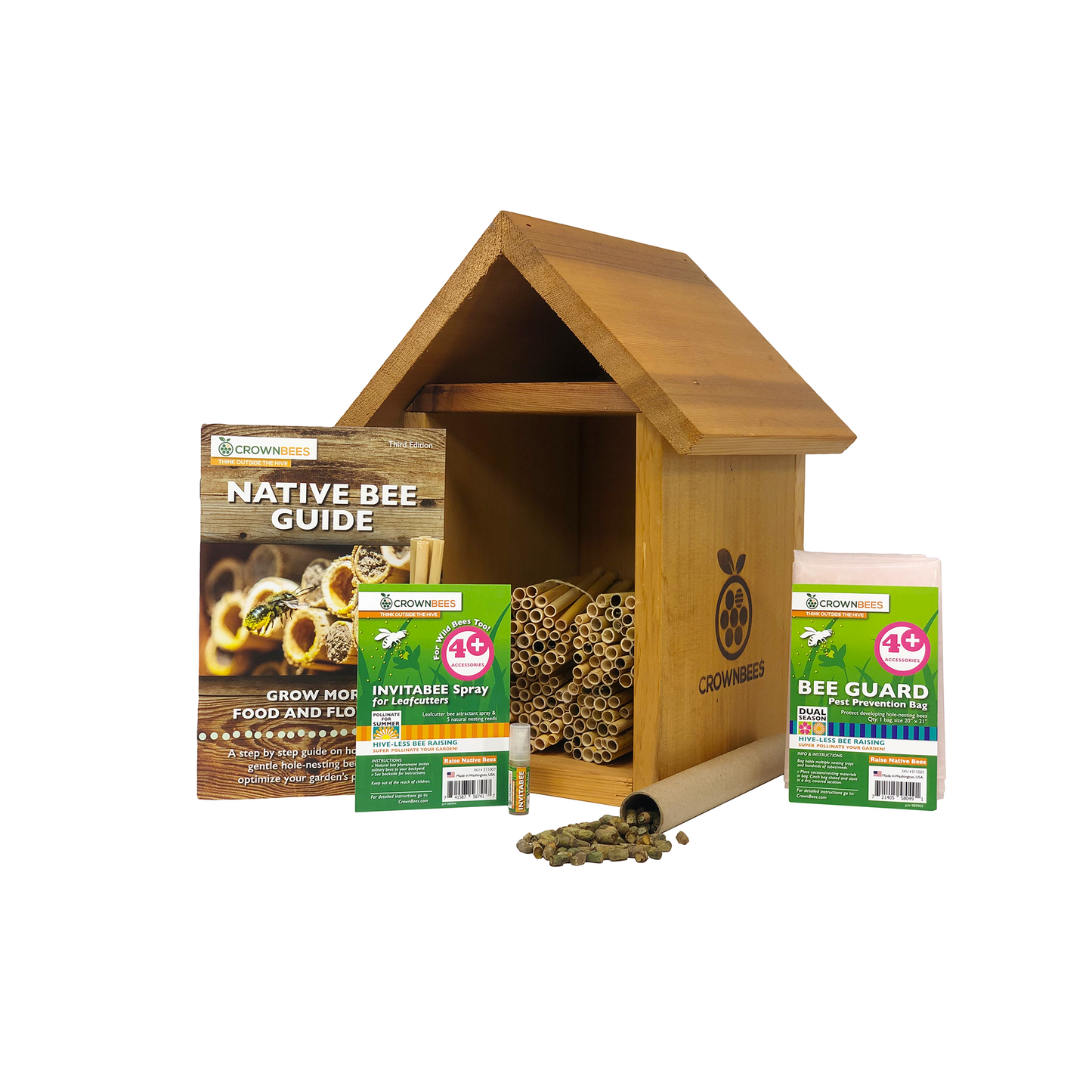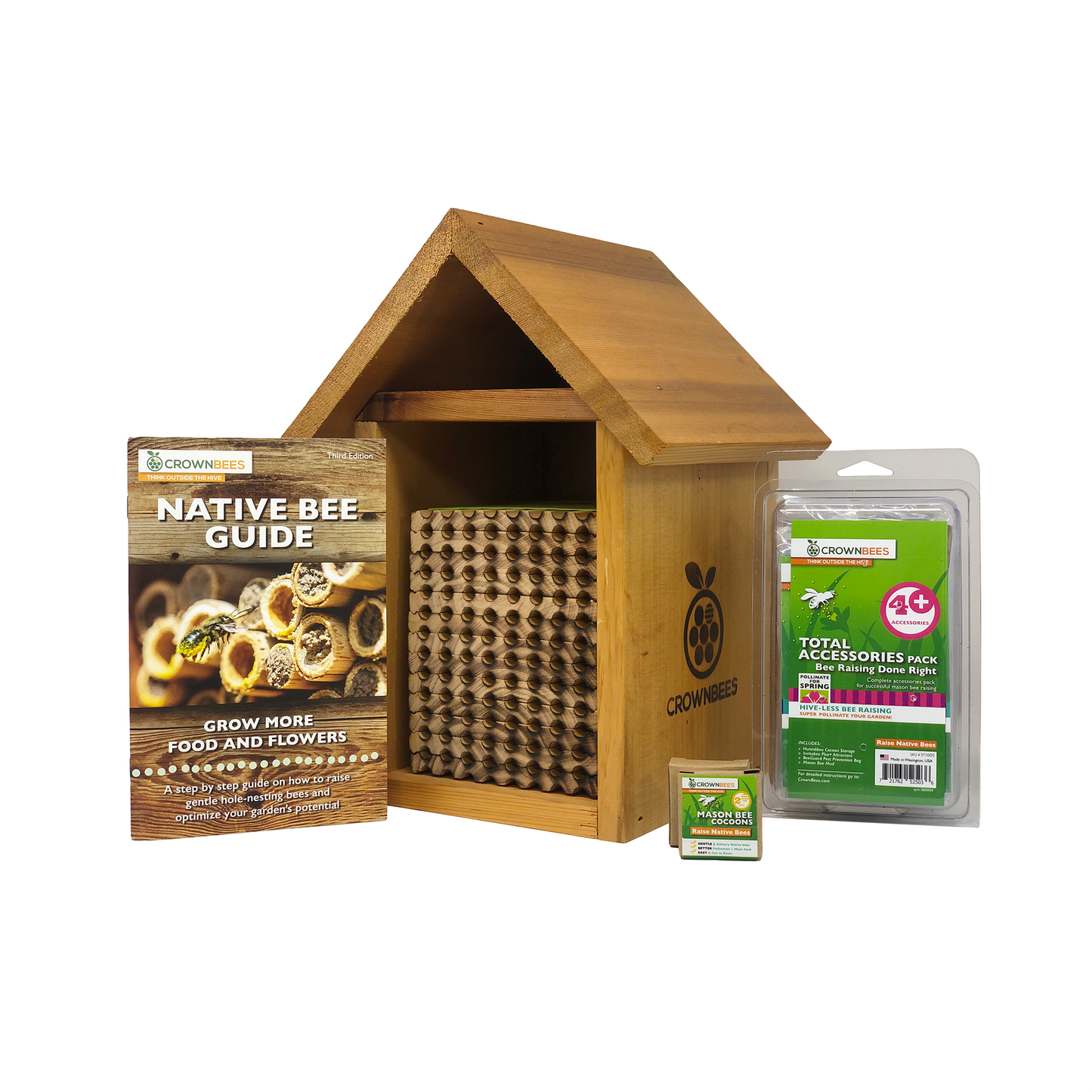
Leafcutter bees are only active in your garden for about 4-6 weeks, beginning in summer. They spend the rest of their lives inside their nesting chambers - eating, growing, spinning cocoons, overwintering as mature larvae, and finally developing into adults when summer temps reach a consistent 70°F/21°C.
Below is an overview of the lifecycle of leafcutter bees. Please note that development and emergence times may be earlier in southern regions and may vary slightly depending on seasonal variations in climate.
Late Spring, Early Summer - Develop, Emerge, and Mate
Leafcutter bees overwinter as dormant, mature larvae. Temperatures 50°F/10°C or cooler keep leafcutter bees in this inactive state.
Once temperatures warm to around 70°F/21°C, the bees begin metamorphosis from larvae to adult bees. The development time from larvae to adults is temperature-dependent. The warmer the temps, the faster bees develop into adults. For example, when daily temps are approximately 70°F/21°C, adults emerge after about 42 days, and at 84°F/30°C, adults emerge after about 20 days.
If you purchase leafcutter bee cocoons from us, we start the incubation process for you, so the bees arrive at your doorstep ready to emerge. Learn more by reading Picking Your Leafcutter Bee Ship Date and Leafcutter Bees by Mail articles.
After emergence, they spend several weeks mating, building nests, collecting food for their offspring, and laying eggs.
Males always emerge first - about two to four days before the first female. Since mating occurs almost immediately after females emerge, it's common to see male bees waiting at the nest or patrolling the surrounding area. Males die shortly after mating.

Summer - Build Nests, Lay Eggs, and Pollinate
Leafcutter bees are cavity-nesting insects. They nest in hollow stems of plants or tunnels or holes formed by wood-boring insects in the wild. This nesting behavior allows us to provide artificial nests constructed of wood trays, bundles of cardboard straws, or natural reeds to help leafcutter bee populations thrive in our backyards and gardens.
When searching for a suitable nest site, a female bee may inspect numerous cavities: tunnel depth, diameter, and nest material influence the ratio of male to female eggs. Leafcutter bees prefer a tunnel depth of about 6 inches, with a cavity diameter of about 6 mm, and the back end of the cavity sealed off to protect from predators.
After selecting a nest site, the bee will fly in a zigzag pattern in front of the nest entrance, memorizing its location. After the bees learn the area, you cannot move the nest. Otherwise, you risk disorienting the bee, often causing her to completely abandon the nest.
Females gather pollen and nectar, lay eggs, and seal egg chambers with leaves or flower petals. These minor cuts do not harm the plants.
Starting at the back of the nesting chamber, the female bee builds a protective leafy wall, which she will pack with a loaf of pollen and nectar (or paste). She then lays a single egg directly on each loaf and seals the chamber with another protective leaf wall. Typically, the females will lay eggs that will become females towards the back of the nest and males near the front. This behavior provides an extra layer of protection for the female eggs.
Leafcutters need soft, flexible leaves and flower petals to build and seal their nests, such as alfalfa, clover, buckwheat, roses, lamb's quarters, lilac, and hostas.

During these foraging trips, the female bee is repeatedly dusted with pollen that remains trapped among the hairs covering her body – this helps to pollinate the flowers she visits.
She repeats these steps until she runs out of space and caps the end with a thick layer of leaves to protect her eggs from predators and inclement weather.
Under suitable conditions, a female bee may finish two to four tunnels in her lifetime, with a rough average of around 30 eggs.
Female bees spend the evening inside the nest, face inwards. Under overcast conditions, during rain, or when temperatures drop below 64°F (18°C), females will remain inside the nest facing outward, guarding against intrusion by other insects. If you take a flashlight out and peek inside the nest at night, you might get a good glance of females staring back out at you!
Fun Fact: Because every female lays eggs, so every female is a queen!
Late Summer, Early Fall - Eggs Hatch, Partially Develop, and Spin Cocoons
As mentioned earlier, the development time for the bee larvae is temperature-dependent. For example, at 60°F (16°C), it takes ≈ 15 days for the eggs to hatch and 35 days for the larvae to reach the prepupal, or mature larvae, stage. But, at 95°F (35°C), it takes only two or three days for eggs to hatch and eleven days to reach the prepupal stage.
Mortality levels can occur during the first or second instar due to nest temperatures above 85°F (27°C). For this reason, we recommend placing your leafcutter house in a shaded area of your yard to protect from extreme summer temps.
When the eggs hatch (after 2-15 days depending on temperature), the bee larvae consume the pollen loaf for approximately 20 days - eventually consuming the entire pollen loaf.

The larvae then spin a waterproof, silk cocoon. During the cocoon spinning process, the larva will turn entirely around inside the cell so that the head ends up facing the nest entrance. The development will cease in colder climates, and the bee will overwinter in this dormant prepupal stage. Managed bees are often placed into cold storage at this stage of development and held until the following season to prevent early emergence.
Unlike mason bees, who only produce a single generation of offspring each year, leafcutter bees are bivoltine, meaning two generations of bees can emerge in a single year! A second generation is not a guarantee but is likely if warm summer temps continue into early fall! Leave your nesting materials in the bee house over the summer, and second-generation bees may emerge.
Evidence of emergence is a large hole in the capped ends and leafy debris. If second-generation bees emerge, you may need to add new clean nesting materials to entice the new bees to stick around. Remember, the bees will also need pollen, nectar, and soft leaves to build their nests!
Fall, Winter, Early Spring - Development Stops Until Next Spring
The development of the bee stops, and the bee remains dormant in the prepupal stage until incubation and metamorphosis occur in late spring, early summer of the following year.
Metamorphosis is the change from prepupae to adult bees. During this time, the larvae will change shape, develop legs, a head, thorax, and abdomen. Next, the eyes will turn pink before darkening to black (female) or green (male). The body will then begin to darken in color, and about one week after darkening, the males will start to emerge, and the cycle starts all over again!



